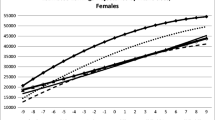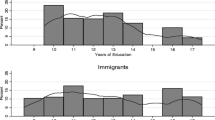Abstract
This paper examines the earnings of foreign-born and native-born men in an attempt to evaluate whether the decline in the quality of Canadian immigrants is related to changes in the country-of-origin mix and the class (type) mix of immigrants. Based on a human capital interpretation, “higher quality” immigrants are defined as immigrants who have smaller on-entry earnings differentials and have earnings that grow at a faster rate (relative to native-born Canadians). The analysis consists of two parts. The first part is based on individual data on earnings and socio-economic characteristics collected in the 1971 and 1986 Canadian Censuses. Earnings equations are estimated for 16 country-of-origin immigrant groups. These regressions are then used to construct a cohort-specific measure of immigrant quality based on the earnings differential between foreign-born and native-born Canadians. In the second part of the analysis, additional regression equations are estimated, pertaining to the period 1968 to 1985, that relate these Census-based measures of immigrant quality to the country-of-origin and class mix of immigrants. In this analysis, unpublished data, supplied by theDepartment of Employment and Immigration, describing the distribution of immigrants across the three main immigrant classes is used. Overall, the analysis confirms that there has been a sharp secular decline in the quality of Canadian immigrants and suggests that it is related to changes in both the country-of-origin and class mix of immigrants.
Similar content being viewed by others
References
Abbott MG, Beach CM (1987) Immigrant earnings differentials and cohort effects in Canada. Discussion Paper no. 705. Kingston, Institute for Economic Research, Queen's University
Beaujot RP, Rappak JP (1988) The role of immigration in changing socio-demographic structures. Population Studies Centre, University of Western Ontario, London
Beaujot RP, Basavarajappa KG, Verma RBP (1988) Income of immigrants in Canada: a census data analysis. Statistics Canada, Ottawa
Bloom DE, Gunderson M (1989) An analysis of the earnings of Canadian immigrants. Discussion Paper no. 437. Department of Economics, Columbia University, New York
Borjas GJ (1985) Assimilation, changes in cohort quality, and the earnings of immigrants. J Labor Econ 3:463–489
Borjas GJ (1987) Self-selection and the earnings of immigrants. Am Econ Rev 77:531–553
Borjas GJ (1989) Immigrant and emigrant earnings: a longitudinal study. Econ Inquiry 27:21–37
Borjas GJ (1991) Immigration policy, national origin, and immigrant skills: a comparison of Canada and the United States. Unpublished mansucript. Department of Economics, University of California, San Diego
Borjas GJ, Bronars SG (1991) Immigration and the family. J Labor Econ 9:123–148
Chiswick BR (1978) The effects of Americanization on the earnings of foreign-born men. J Polit Econ 86:897–921
Chiswick BR (1986) Is the new immigration less skilled than the old? J Labor Econ 4:168–192
Chiswick BR, Miller PW (1988) Earnings in Canada: the roles of immigrant generation, French ethnicity, and language. Res Popul Econ 6:183–228
Chiswick BR, Miller PW (1990) Language in the labor market: the immigrant experience in Canada and the United States. Unpublished manuscript. Department of Economics, University of Illinois at Chicago, Chicago
Coulson RG, DeVoretz DJ (1990) Human capital content of Canadian immigration 1966–1987. Unpublished manuscript. Department of Economics, Simon Fraser University, Burnaby, BC
DeVoretz DJ, Fagnan S (1990) Some evidence on Canadian immigrant quality decline: foreign-born versus resident-born Earnings functions for 1971–1986. Unpublished manuscript. Department of Economics, Simon Fraser University, Burnaby, BC
Fenwick R (1982) Ethnic culture and economic structure: determinants of French-English earnings inequality in Quebec. Soc Forces 61:1–23
Heckman JJ, Robb R (1983) Using longitudinal data to estimate age, period and cohort effects in earnings equations. In: Winsborough H, Duncan O (eds) Analyzing longitudinal data for age, period, and cohort effects. Academic Press, New York
Maxim PS (1992) Immigrants, visible minorities, and self-employment. Demography 29:181–198
Meng R (1987) The earnings of Canadian immigrant and native-born males. Appl Econ 19:1107–1119
Mincer J (1974) Schooling, experience and earnings. National Bureau of Economic Research, New York
Nakamura A, Nakamura M (1990) Wage rates of immigrant and native men in Canada and the U.S. Unpublished manuscript. Faculty of Business, University of Alberta, Edmonton
Tandon BB (1978) Earnings differentials among native born and foreign born residents in Toronto. Inter Migration Rev 12:406–410
Wright RE, McDade K (1992) Barriers to the recognition of the credentials of immigrants in Canada: an analysis using census data. Institute for Research on Public Policy, Montreal
Author information
Authors and Affiliations
Rights and permissions
About this article
Cite this article
Wright, R.E., Maxim, P.S. Immigration policy and immigrant quality. J Popul Econ 6, 337–352 (1993). https://doi.org/10.1007/BF00599042
Received:
Accepted:
Issue Date:
DOI: https://doi.org/10.1007/BF00599042




